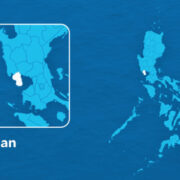BFAR vessels come under China water cannon attack
Three vessels of the Bureau of Fisheries and Aquatic Resources (BFAR) became the latest targets of water cannon attacks by the China Coast Guard (CCG) in the West Philippine Sea.The National Task Force for the West Philippine Sea (NTF-WPS) “vehemently condemn(ed) the illegal and aggressive actions” taken by the CCG and the Chinese maritime militia against the BFAR boats, which were then on their way to bring supplies to Filipino fishermen near Bajo de Masinloc (Scarborough Shoal) off Zambales province.
According to the task force, the Datu Sanday, Datu Bankaw, and Datu Tamblot were on a “regular humanitarian and support mission” on Saturday morning to deliver fuel and groceries to more than 30 Filipino fishing boats waiting about a nautical mile to the entrance of the shoal.The incident was the third time this year that the CCG used water cannons to stop Philippine civilian vessels. In earlier blockade attempts, the Chinese used similar tactics on the Philippine Coast Guard (PCG) resupply missions to the BRP Sierra Madre, the grounded ship serving as a military outpost at Ayungin (Second Thomas) Shoal, on Aug. 5 and Nov. 10.
Located some 220 kilometers west of Zambales, Bajo de Masinloc, also called Panatag Shoal, lies within the country’s 370-km exclusive economic zone. China seized control of the shoal in 2012 after a tense standoff with the Philippine Navy. The government under then President Benigno Aquino III filed an arbitration case against Beijing before an international tribunal the following year. China does not recognize the 2016 arbitral ruling that invalidated its claim to up to 90 percent of the South China Sea, including Bajo de Masinloc.
‘Most aggressive’
According to Filipino TV journalists who covered the BFAR mission, the bureau’s vessels encountered two CCG ships—with bow numbers 3305 and 3302—and at least four maritime militia boats some 2.6 km away from Bajo de Masinloc. The CCG ships started firing their water cannon around 9 a.m. to prevent the BFAR boats from approaching the Filipino fishing vessels. This went on up to around 1 p.m., according to the journalists who posted what they were witnessing on social media.
An NTF-WPS statement, which was issued at 4 p.m. to condemn the latest Chinese harassment, said the BFAR mission was still ongoing at the time.
The task force spokesperson, Jonathan Malaya, said the Chinese used their water cannons at least eight times and caused “significant damage to BFAR vessel Datu Tamblot’s communication and navigation equipment, as it was directly and deliberately targeted by the CCG.”The BFAR, an attached agency of the Department of Agriculture, said it was the “most aggressive action” ever faced by its personnel at sea and the first to be inflicted upon them by the CCG using water cannons.
Earlier BFAR missions to the shoal were met only with radio challenges or merely shadowed by the CCG and the Chinese maritime militia, it said.LRAD also usedThe NTF-WPS said the maritime militia also took part in the blockade by making “dangerous maneuvers” and targeting the BFAR vessels with a long-range acoustic device (LRAD), the latter “causing severe temporary discomfort and incapacitation to some Filipino crew.”The NTF-WPS also reported that the Chinese deployed teams on inflatable boats to drive away the Filipino fishermen who had been waiting for the BFAR mission.
“To prevent the distribution of humanitarian support is not only illegal but also inhumane,” Malaya said. The Filipino fishermen later told authorities that they saw the CCG installing a floating barrier at the southeast entrance to Bajo de Masinloc earlier on Saturday. In September, on President Marcos’ orders, the PCG removed a similar barrier put up by the CCG in the area.“We stress that Bajo de Masinloc is a high-tide feature with territorial sea, per the 2016 arbitral award. It forms an integral part of the Philippine national territory under the Constitution. The Philippines exercises sovereignty and jurisdiction over the shoal and its territorial sea,” Malaya said.“The 2016 arbitral award has also clarified that Filipinos have traditional fishing rights in the waters of Bajo de Masinloc protected by international law,” he added.
The NTF-WPS demanded that Beijing take “immediate action” to stop the CCG’s aggressive activities and uphold the principles of international law.It also called on China to desist from actions that would infringe on Philippine sovereignty and endanger the lives and livelihood of Filipino fishermen, for whom the shoal is a traditional fishing ground.
“China’s illegal exercise of maritime law enforcement powers, interference with Philippine vessels, harassment and intimidation of Filipino fisherfolk, or any other activity that infringes upon the Philippines’ sovereignty and jurisdiction in Bajo de Masinloc, are violations of international law, particularly Unclos (United Nations Convention on the Law of the Sea) and the arbitral award,” Malaya said.‘Control measures’
“We firmly insist that these Chinese vessels leave Bajo de Masinloc immediately,” he added.
Defending its actions against the BFAR mission, the CCG on Saturday said it undertook “control measures” in accordance with Chinese laws, insisting that the Philippine vessels where the ones that “intruded” into the waters around Huangyan Island, the name China gave to Bajo de Masinloc.
The CCG statement was posted on the X (formerly Twitter) account of the People’s Daily, the official news outlet of the Central Committee of the Chinese Communist Party.Saturday’s incident also took place a day after a civilian humanitarian convoy left Manila on a three-day voyage to bring Christmas gifts and other supplies to Filipino forces and island settlers in the West Philippine Sea. INQ
















